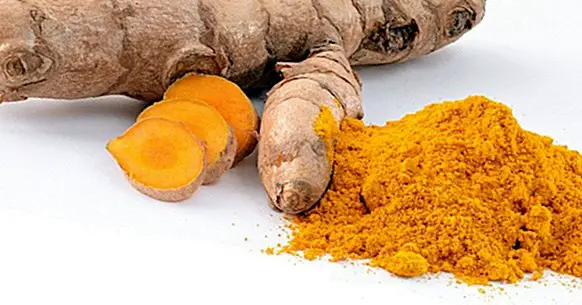Turmeric: its 10 benefits and healing properties
There is a great diversity of plant species in nature, among which many are edible for humans. Fruit trees, vegetables, legumes, cereals ... all of them are an indispensable part of our diet.
In addition to them we can also find other types of plants that we use more as a condiment, although they are still of great relevance to us and even form part of the traditional cuisine of multiple cultures.
One of them is turmeric , which in addition to being one of the main ingredients of curry has been part since antiquity of Asian cultures like the one of India and that every time receives greater attention due to its numerous beneficial properties. It is about this vegetable that we are going to talk about throughout this article.
- Related article: "18 benefits of ginger for your body and your health"
What is turmeric?
It is known as turmeric an aromatic herbaceous plant which is part of the Zingiberáceas family and whose scientific name is Curcuma longa. This plant is native to the territories of Southeast Asia, in which it is highly known since antiquity, and unlike others does not reproduce by seeds but by the use of cuttings. The part of the turmeric that is most often used is the rhizome or subterranean stem, from which the roots divide.
The best-known use of this plant is the gastronomic one, in which it is usually used as an aromatic spice (which is obtained by grinding the rhizome of the plant) and used as a seasoning in different preparations, including the famous and already mentioned curry. It is also sometimes used in infusions. While It is a traditional food in Asian countries and especially in India , little by little the use of this spice has been expanding.
It is also sometimes used as a food that helps treat various conditions and minor ailments, knowing many of its properties since ancient times and being some of them endorsed by science. It also has other uses, such as dye or coloring.
In this sense, an orange food coloring has also been generated, the E-100, in addition to being used in the coloring of paints and clothing. It is also part of various religious and cultural traditions (For example, it is one of the plants that is used as a dye to draw the traditional mark on the forehead that the Indian population usually carries).
Main benefits and properties of this plant
There are multiple properties and benefits that have been attributed to turmeric, some of which have been scientifically verified. Generally one of the most studied elements at this level is curcumin, the natural dye derived from turmeric. Below we will explain some of the most known benefits and properties.
1. It has anti-inflammatory properties
Several investigations carried out in animal models seem to indicate that the administration of turmeric and / or curcumin has anti-inflammatory effects, reducing the emission of cytokines (which are proinflammatory) and inhibiting the inflammatory prostaglandins.
In this sense it can be useful in conditions such as arthritis or psoriasis, and It has been shown effective in the reduction of edema and granulomas , in addition to the treatment of asthma. These effects are observed in different organs, both at the ectopic and respiratory levels, among others.
2. Antitumor effect
Although it is far from being a miraculous product in this regard, it has been observed that the administration of turmeric has a certain anticancer effect, helping to reduce the growth of neoplasms by inhibiting the expression of tumor necrosis factors and various interleukins (which favor the development and growth of tumors). Its anti-inflammatory property also contributes to this.
3. An interesting antioxidant
Another of the proven properties of turmeric is its antioxidant action, through which slows down the generation and effects of free radicals that cause cell aging . These effects have been seen at the blood level, protecting from the oxidation of hemoglobin and lipids. This also includes a protective effect against Alzheimer's, by reducing the appearance of beta-amyloid plaques.
4. Hypoglycemic and diabetes aids
Some studies indicate that curcumin has hypoglycemic capacity, that is, it helps reduce blood sugar levels. further it has also been observed that it favors an increase in insulin and a reduction of cholesterol.
5. Protects the intestine and liver
Partly thanks to its anti-inflammatory, antioxidant and hypoglycaemic activity, it has been observed that turmeric helps maintain the digestive tract in good health , as well as having hepatoprotective properties. It also facilitates the flow of bile, something that also facilitates the digestion of fats.
6. Healing
In addition to being used as an anti-inflammatory at the skin level, turmeric has also been used topically since it also has antioxidant and astringent effects, something that favors the closing of wounds . It is used for example in burns.
- Maybe you're interested: "Aloe vera: 13 benefits you should know and apply to your life"
7. Protects the heart, reduces cholesterol and prevents heart disease
It has been observed that turmeric is useful in preventing heart disease, given that reduces the inflammation and oxidation that may favor them and also has antiplatelet capacity . In this sense it is very useful since it hinders the creation of thrombi and also contributes to reduce cholesterol.
8. Antibiotic properties
In addition to all the above, it has been observed that turmeric has antibacterial, antifungal and antiprotozoal effects, something that helps to fight against some infections and parasites.
9. Its usefulness in HIV is investigated
Some studies suggest that turmeric and products derived from its active ingredients may be useful for people with HIV, as it seems contribute to slow the expansion of the retrovirus by affecting the intergrase of HIV-1 .
10. It improves the mood
Finally, it is worth mentioning that another of the interesting properties of turmeric is the fact that it contributes to reducing the levels of stress and depression to the Contribute to modulate the neurotransmission of certain hormones .
Bibliographic references:
- Ammon, H.P.T. & Wahl, M.A. (1991). Pharmacology of Curcuma longa. Planta Medica, 57 (1): 1-7. Georg Thieme Verlag Stuttgart. New Work
- Araujo, C.A.C. & Leon, L.L. (2001). Biological Activities of Curcuma longa L. Memories of Oswaldo Cruz Institute, 96 (5): 723-728. Rio de Janeiro.
- Díaz Ortega, J.L. (2014). Curcuma Longa and its beneficial molecular potential on inflammatory processes, cancer and chronic degenerative diseases. IN CRESCENDO Magazine- Health Sciences, 1 (1): 115-124.
- Saiz de Cos, P. (2014). Curcuma I (Curcuma longa L.). Reduca (biology). Botanical Series, 7 (2): 84-99.



















